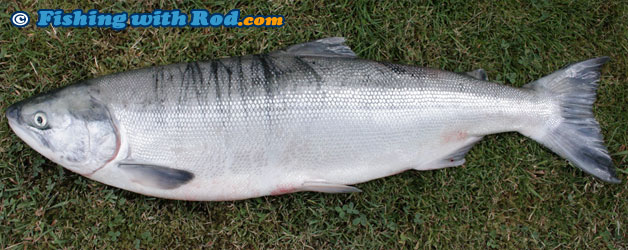Sockeye Salmon
Oncorhynchus nerka

When mentioning Pacific salmon in British Columbia, most will immediately think of sockeye salmon. It is an important species in the commercial and recreational fishing sectors, as well as First Nations' culture. Sockeye salmon return from the Pacific Ocean to the Fraser River in British Columbia every summer in large abundance. They are primarily fished for food due to the fine taste of their meat, but can also be excellent gamefish in both salt and freshwater.
Description
Like other Pacific salmon species, sockeye salmon have a silver, streamline body during their adult stage in the ocean. Their back is greenish-blue and spotless. Their tail is also spotless. Occasionally, some spots can be found on the dorsal fin. Once sockeye salmon return to their spawning ground, their body becomes bright red and their head is olive green. Average size of sockeye salmon are between 6 and 8lb, while larger specimen are found in some stocks such as the Adams River run.
Distribution
Most coastal rivers in British Columbia have a population of sockeye salmon. The largest run is the Fraser River, which is then categorized into smaller runs from its tributaries. These smaller runs are found as far north as Prince George and as close to the ocean as Chilliwack River. On Vancouver Island, the Stamp River has the biggest run in the region. In July and August, after spending a couple of years in the North Pacific, sockeye salmon are found in BC's in-shore waters where they stage and feed before entering their spawning streams. Landlocked populations, known as kokanee, are also found in many lakes across British Columbia.
Life History
Sockeye salmon have an anadromous life cycle, meaning that they spend their juvenile stage in rivers and adult stage in the ocean. The exact migratory pattern differs from one population to another. Once hatched from gravel in spring, juveniles of some population travel straight into the ocean during their first summer, while juveniles of other populations may spend one, or sometimes two years in streams or lakes before making the saltwater journey. Once becoming pelagic in the ocean, they feed on plankton and sometimes small fish. Adult sockeye salmon can spend two to three years in the ocean before returning and spawning in their natal streams. Offsprings of sockeye salmon can sometimes become landlocked kokanee, while offsprings of kokanee can sometimes become anadromous.
Fishing Locations
In Vancouver, sockeye salmon fishing season usually takes place from mid July to early September, depending on the status of each stock. Fishing is done in Georgia Strait and the Fraser River mouth by trolling. In the Lower Fraser River from Steveston to Lytton, seasonal openings of sockeye salmon fishing are also available in August. On Vancouver Island, Alberni Inlet provides a popular sockeye salmon fishery in July.
Fishing Techniques
Sockeye salmon are primarily done by trolling when targeted in the ocean. Hootchies and spoons are two common lures used for trolling. While hundreds of colour patterns are available, every seasoned sockeye salmon angler has his or her own preferred colour.
In streams, sockeye salmon can be caught by float fishing with krill, shrimp or roe. They are light biters so a sensitive float setup is required.
In the Lower Fraser River, due to the poor water clarity, sockeye salmon are unlikely to bite your presenation. Occasionally, they are caught by bar fishing, a technique used to target chinook salmon. Most sockeye salmon are caught by flossing, which is a technique that has been accepted by majority of the recreational fishing community and Fisheries and Oceans Canada. Flossing involves lining your hook with salmon that are travelling upstream so they are hooked in the mouth by accident.
